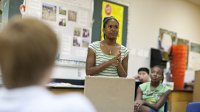A Schoolwide Exhibition Builds Excitement for Project-Based Learning
Interdisciplinary project-based learning encourages teacher collaboration, and a whole-school showcase is deeply engaging for students.
Your content has been saved!
Go to My Saved Content.Several years ago, our district unveiled a “Profile of a Graduate” initiative, which designated skills that all students leaving our district should have. These skills, which include creativity, communication, and collaboration, among others, were to be taught using authentic, meaningful learning experiences. To meet this opportunity head-on, the middle school where I teach committed to creating an exhibition night at the close of each semester. The exhibition would showcase personalized learning and interdisciplinary projects, including project-based learning.
Rolling all of that up into one was a challenge, but it was also incredibly rewarding.
A Vision for the Showcase
Teachers from each grade level and our building administrator created semester-long, hands-on interdisciplinary projects; within each project, students could choose to work individually or in groups before creating projects for the exhibition. That capstone event would feature three essential elements.
Professionalism: Students would engage in work similar to that of professionals in our content areas but at a middle-school-friendly level. For example, students would conduct research as historians do and use math to solve real-world problems.
A single driving question: No matter what the content area, each student project exhibited would respond to one open-ended, engaging question that was related to our content standards. Tubric, a tool from PBLWorks at the Buck Institute for Education, helped us refine the questions. We landed on prompts including “How does my brain health affect my ability to think, learn, and respond?” and “How might we create a National History product using historical inquiry and argumentation?”
Public exposure: To help build students’ awareness of the value of their work, the exhibition needed to reach an audience beyond parents. We would engage local professionals in the feedback process both at mid-project checkpoints and at the final exhibition so that students received input and validation from experts.
Brick-and-Mortar Implementation
The first exhibition was held at our school just prior to the pandemic. The school was transformed into an interactive museum that featured student products everywhere visitors looked. Sixth-grade students played the Native American game called shinny with their parents after reading voyager journals describing the exploration of Minnesota. In the gym, sixth-grade students demonstrated to their families knowledge of science and math by firing trebuchets and plotting how data changed based on the weight of the projectile. Elsewhere, seventh-grade students presented their National History Day and Google Science Fair projects on topics like the impact of Title IX throughout history and the durability of carbon. Meanwhile, eighth graders played an interdisciplinary game based on Settlers of Catan.
Parent and teacher feedback was swift and positive. The exhibition demonstrated learning in a different way than traditional reports—and everyone wanted more.
Virtual Implementation
In the face of the pandemic, we pivoted to a virtual showcase, and we found that many aspects worked surprisingly well—some even better in a remote setting.
We started by creating a single Google Sites website to house all links for each showcase project. Each teaching team built in an opportunity for feedback from an outside audience on student products; Google forms were embedded in each student project to solicit that feedback.
The exhibition website went live the night of the showcase for viewing. Although there were no live presentations, projects still covered each content area.
For example, seventh graders presented online products for the National History Day project; they developed a historical argument on a topic of their choice that they defended with a thesis statement, creating products such as exhibits, documentaries, research papers, performances, or websites, blending historical inquiry with ELA. Each student’s product was then judged by a parent or community member.
Then there was the “Healthy in the 2020s” project, which integrated health, PE, math, and science by asking students to share their understanding of how to stay physically, socially, emotionally, and spiritually healthy during the pandemic. In addition to coursework, students engaged with local professionals to further define how the world around us impacts our health. Students presented their solutions for how to stay healthy with Flipgrid and will record Spotify podcasts this spring.
Reflections Moving Forward
Interdisciplinary projects are wonderful, but we found that the standards that connect across all disciplines were often not of the same depth and breadth and required varying time commitments from each teacher. Also, there was the efficiency aspect: We spent two weeks on one standard when, if it were taught in the traditional sense, it could be done in less time. Moving forward, we are not going to try to run a single project that encompasses an entire grade, but instead we will encourage teachers to work together in smaller groups to find deeper, more organic content connections.
Moreover, while we will shift back to in-person exhibition nights post-pandemic, there were benefits to an online model. First of all, a virtual event was significantly easier on families; parents repeatedly told us how grateful they were that the students didn’t have to present live because of family and work schedules. A virtual showcase also allowed parents to engage with their student’s learning while freeing up another night at home.
A virtual exhibition night showed us that a single project run by one or perhaps two teachers at most is ideal. Merging more than two or three content areas into a single project led to cross-curricular connections, but the complexity of that endeavor often led to surface-level, inorganic learning. In addition, having smaller teams of teachers resulted in faster decision-making during planning.
